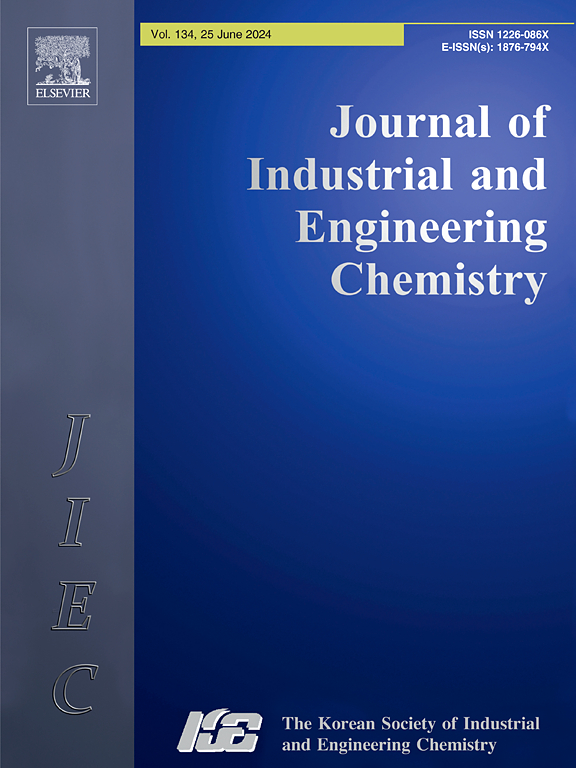A high throughput co-flow millifluidic device for homogeneous nanoparticle synthesis
IF 5.9
3区 工程技术
Q1 CHEMISTRY, MULTIDISCIPLINARY
Journal of Industrial and Engineering Chemistry
Pub Date : 2025-01-27
DOI:10.1016/j.jiec.2025.01.023
引用次数: 0
Abstract
Nanoparticle (NP) and its encapsulation have received increasing attention due to their potential applications in various industrial sectors. However, conventional batch NP synthesis processes have shortcomings including limited batch-to-batch reproductivity, and nonhomogeneous particle chemical and physical properties. In this work, a novel polydimethylsiloxane (PDMS) based co-flow millifluidic (CFM) device was developed to achieve a rapid and precise control of the mixing of two fluids through vortices and turbulence for nanoparticle synthesis and encapsulation. The flow behavior phase diagram was obtained by operating the CFM device under different flow rates of the fluids that generated different flow types such as laminar jet flow, confined laminar flow, transition, turbulent jet flow and micro-vortices and turbulence flows. In addition, a computational study was conducted to understand the flow characteristics in these flow regimes. At last, polystyrene (PS) NPs and perylene-encapsulated polystyrene nanoparticles (P-ENP) were synthesized using the CFM device. The comparison of the size distribution of PS NPs with those from bulk synthesis shows that the CFM device can synthesize NPs and ENPs with much smaller sizes and more uniform size distributions. The developed CFM device shows great potential as a powerful platform for high throughput production of NPs and ENPs.
一种用于均匀纳米颗粒合成的高通量共流微流控装置
纳米粒子及其封装技术在工业领域的应用前景日益受到人们的关注。然而,传统的批量NP合成工艺存在着批间再生率有限、颗粒化学和物理性质不均匀等缺点。在这项工作中,开发了一种新型的基于聚二甲基硅氧烷(PDMS)的共流微流控(CFM)装置,以实现对两种流体通过涡流和湍流混合的快速精确控制,用于纳米颗粒的合成和封装。通过对CFM装置进行运行,得到了产生层流射流、受限层流、转捩、湍流射流、微涡和湍流等不同流型的流体在不同流速下的流动特性相图。此外,还进行了计算研究,以了解这些流型中的流动特性。最后,利用CFM装置合成了聚苯乙烯(PS)纳米粒子和聚苯乙烯包封纳米粒子(P-ENP)。通过与体合成NPs的尺寸分布比较,表明CFM装置可以合成尺寸更小、尺寸分布更均匀的NPs和ENPs。所开发的CFM装置显示出作为高通量生产NPs和ENPs的强大平台的巨大潜力。
本文章由计算机程序翻译,如有差异,请以英文原文为准。
求助全文
约1分钟内获得全文
求助全文
来源期刊
CiteScore
10.40
自引率
6.60%
发文量
639
审稿时长
29 days
期刊介绍:
Journal of Industrial and Engineering Chemistry is published monthly in English by the Korean Society of Industrial and Engineering Chemistry. JIEC brings together multidisciplinary interests in one journal and is to disseminate information on all aspects of research and development in industrial and engineering chemistry. Contributions in the form of research articles, short communications, notes and reviews are considered for publication. The editors welcome original contributions that have not been and are not to be published elsewhere. Instruction to authors and a manuscript submissions form are printed at the end of each issue. Bulk reprints of individual articles can be ordered. This publication is partially supported by Korea Research Foundation and the Korean Federation of Science and Technology Societies.

 求助内容:
求助内容: 应助结果提醒方式:
应助结果提醒方式:


